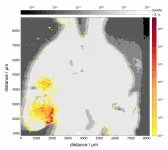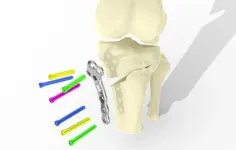Swarm of autonomous tiny drones can localize gas leaks
2021-07-14
(Press-News.org) When there is a gas leak in a large building or at an industrial site, human firefighters currently need to go in with gas sensing instruments. Finding the gas leak may take considerable time, while they are risking their lives. Researchers from TU Delft (the Netherlands), University of Barcelona, and Harvard University have now developed the first swarm of tiny - and hence very safe - drones that can autonomously detect and localize gas sources in cluttered indoor environments.
The main challenge the researchers needed to solve was to design the Artificial Intelligence for this complex task that would fit in the tight computational and memory constraints of the tiny drones. They solved this challenge by means of bio-inspired navigation and search strategies. The scientific article has now been made public on the ArXiv article server, and it will be presented at the renowned IROS robotics conference later this year. The work forms an important step in the intelligence of small robots and will allow finding gas leaks more efficiently and without the risk of human lives in real-world environments.
Autonomous gas source localization
Autonomous gas source localization is a complex task. For one, artificial gas sensors are currently less capable than animal noses in detecting small amounts of gas and staying sensitive to quick changes in gas concentration. Moreover, the environment in which the gas spreads can be complex. Consequently, much of the research in this area has focused on single robots that search for a gas source in rather small, obstacle-free environments in which the source is easier to find.
Swarms of tiny drones
"We are convinced that swarms of tiny drones are a promising avenue for autonomous gas source localization", says Guido de Croon, Full Professor at the Micro Air Vehicle laboratory of TU Delft. "The drones' tiny size makes them very safe to any humans and property still in the building, while their flying capability will allow them to eventually search for the source in three dimensions. Moreover, their small size allows them to fly in narrow indoor areas. Finally, having a swarm of these drones allows them to localize a gas source quicker, while escaping local maxima of gas concentration in order to find the true source."
However, these properties also make it very hard to instill the drones with the necessary artificial intelligence for autonomous gas source localization. The onboard sensing and processing is extremely limited, excluding the type of AI algorithms that make self-driving cars autonomous. Moreover, operating in a swarm brings its own challenges, since the drones need to be aware of each other for collision avoidance and collaboration.
Bio-inspired Artificial Intelligence
"Actually, in nature there are ample examples of successful navigation and odor source localization within strict resource constraints.", says Bart Duisterhof, who performed the research for obtaining his MSc thesis at TU Delft. "Just think of how fruitflies with their tiny brains of ~100,000 neurons infallibly locate the bananas in your kitchen in the summer. They do this by elegantly combining simple behaviors such as flying upwind or orthogonally to the wind depending on whether they sense the odor. Although we could not directly copy these behaviors due to the absence of airflow sensors on our robots, we have instilled our robots with similarly simple behaviors to tackle the task."
In particular, the tiny drones implement a new "bug" algorithm for their navigation, termed "Sniffy Bug". As long as no drone has sensed any gas, the drones spread out as much as possible over the environment, while avoiding obstacles and each other. If one of the drones senses gas at its location, it communicates this to the others. From that point on, the drones will collaborate with each other to find the gas source as soon as possible. Specifically, the swarm then performs a search for maximal gas concentration with an algorithm termed "particle swarm optimization" (PSO), with each drone being a "particle". This algorithm was originally modelled after the social behavior and motion of bird flocks. It has each drone moving based on its own perceived highest gas concentration location, the swarm's highest location, and an inertia in its current moving direction. As a search strategy, PSO has the advantage that it only requires measuring the gas concentration, and not the gas concentration gradient or wind direction. Furthermore, it allows the swarm to ignore local maxima that may occur in complex environments.
The path to real-world applications
"This research shows that swarms of tiny drones can perform very complex tasks.", adds Guido, "We hope that this work forms an inspiration for other robotics researchers to rethink the type of AI that is necessary for autonomous flight."
The development of this type of technology to a fully functioning product still requires further work. For instance, the current work does not yet tackle moving in three dimensions to locate gas sources at a height. Furthermore, the robustness of navigation should also be improved before deploying the drones in a real emergency scenario.
However, the current work is very promising. The developed algorithms are not only useful for detecting gas leaks in buildings, but also for scientific missions such as detecting methane on Mars or economical use such as the early detection of diseases or pests in greenhouses.
INFORMATION:
More information
Scientific article:
Sniffy Bug: A Fully Autonomous Swarm of Gas-Seeking Nano Quadcopters in Cluttered Environments, by B.P. Duisterhof, S. Li, J. Burgués, V.J. Reddi, and G.C.H.E. de Croon, accepted at IEEE/RSJ International Conference on Intelligent Robots and Systems 2021 (IROS 2021). - Preprint available at the Arxiv: https://arxiv.org/abs/2107.05490
Video at: https://youtu.be/hj_SBSpK5qg
Video playlist: https://www.youtube.com/playlist?list=PL_KSX9GOn2P-J5qh90Y-9fw2ODcxYtFap
More information at: http://mavlab.tudelft.nl/
[Attachments] See images for this press release:

ELSE PRESS RELEASES FROM THIS DATE:
2021-07-14
A new study finds forensics researchers use terms related to ancestry and race in inconsistent ways, and calls for the discipline to adopt a new approach to better account for both the fluidity of populations and how historical events have shaped our skeletal characteristics.
"Forensic anthropology is a science, and we need to use terms consistently," says Ann Ross, corresponding author of the study and a professor of biological sciences at North Carolina State University. "Our study both highlights our discipline's challenges in discussing issues ...
2021-07-14
Super-thin carbon molecular sieve (CMS) membranes may not be best for separating industrially important chemical mixtures. However, ensuring the CMS film thickness is just right could enable more energy-efficient purification of chemical products, KAUST researchers have shown.
CMS membranes, as their name suggests, can purify mixtures of liquids or gases by permitting only certain molecules to pass through their subnanometer-sized pores. Currently, the chemical industry mainly uses heat-based processes such as distillation to separate product mixtures, but these processes consume about 10 percent of global energy output. "This situation is highly unsustainable," says Wojciech Ogieglo, a research scientist at KAUST. "We believe that a good ...
2021-07-14
The premise of heated tobacco (HT) is simple: tobacco leaf is heated, never burnt, so avoiding many harmful by-products of combustion for the user. The exhaled 'mist' is correctly termed an aerosol, which is almost invisible and far less dense and pungent than the exhaled smoke from combustible cigarettes.
Another advantage of HT is that there are no 'side-stream' emissions to impact air quality (or disturb bystanders - these emissions form part of the ambient smoke that's often known as environmental tobacco smoke (ETS) or 'second-hand' smoke), because unlike a combustible cigarette there is no constantly burning tip. Our previous research suggests that, unlike cigarettes, using our Pulze heated tobacco device causes no negative impact on indoor air quality ...
2021-07-14
Researchers have found evidence for an anomalous phase of matter that was predicted to exist in the 1960s. Harnessing its properties could pave the way to new technologies able to share information without energy losses. These results are reported in the journal Science Advances.
While investigating a quantum material, the researchers from the University of Cambridge who led the study observed the presence of unexpectedly fast waves of energy rippling through the material when they exposed it to short and intense laser pulses. They were able to make these observations by using a microscopic speed camera that can track small and very fast movement on a scale that is challenging with many other techniques. This technique probes the material with two light pulses: the first one disturbs it ...
2021-07-14
In lab tests, Imperial researchers have created a metal-based molecule that inhibits the build-up of a peptide associated with Alzheimer's disease.
A peptide is a fragment of a protein, and one of the key hallmarks of Alzheimer's disease is the build-up of a specific peptide known as amyloid-β. The team demonstrated that with the aid of ultrasound, their molecule can cross the blood-brain barrier in mice, targeting the part of the brain where the damaging peptide most often accumulates.
Alzheimer's disease is the most common form of dementia, affecting approximately 50 million people worldwide. There is a pressing need to develop drugs ...
2021-07-14
Pioneering 'printed metal' procedure to create bespoke treatment for early knee osteoarthritis set to be trialled in the UK following MHRA approval.
World's first 3D printed high tibial osteotomy (HTO) device and procedure developed at University of Bath given approval for UK trials
Bespoke titanium alloy HTO implants that fit perfectly are designed to reduce discomfort for knee osteoarthritis patients
Sophisticated 3D scanning aims to make surgery quicker and safer
New TOKA process could make earlier intervention possible - saving patients decades of pain before surgery becomes viable
Intro
A ...
2021-07-14
Many of us swing through gates every day -- points of entry and exit to a space like a garden, park or subway. Electronics have gates too. These control the flow of information from one place to another by means of an electrical signal. Unlike a garden gate, these gates require control of their opening and closing many times faster than the blink of an eye.
Scientists at the U.S. Department of Energy's (DOE) Argonne National Laboratory and the University of Chicago's Pritzker School of Molecular Engineering have devised a unique means of achieving effective gate operation with a form of information processing called electromagnonics. Their pivotal discovery allows real-time control of information transfer between microwave photons and magnons. And it could result in a new generation ...
2021-07-14
An important new study by researchers at the U.S. Department of Energy's (DOE) Argonne National Laboratory has yielded critical fresh insights into the lithium production process and how it relates to long-term environmental sustainability, particularly in the area of transportation with batteries and electric vehicles.
The paper, "Energy, Greenhouse Gas, and Water Life Cycle Analysis of Lithium Carbonate and Lithium Hydroxide Monohydrate from Brine and Ore Resources and Their Use in Lithium Ion Battery Cathodes and Lithium Ion Batteries," in the journal ...
2021-07-14
Prof. PAN Jianwei and Prof. ZHANG Jun from University of Science of Technology of China (USTC) of the Chinese Academy of Sciences, collaborating with Prof. CHU Tao's group from Zhejiang University, realized the fastest and miniaturized real-time quantum random number generator (QRNG) with the record-breaking output rate of 18.8 Gbps by combing a state-of-the-art photonic integrated chip with the optimized real-time post processing. The study was published in Applied Physics Letters on June 29.
Random number exists in many fields such as information security and cryptology industries. Different from other random number generators, QRNG, as the key part in quantum communication system, embraces the characteristics ...
2021-07-14
Prof. DU Jiangfeng, Prof. RONG Xing, and their colleagues from the Key Laboratory of Micromagnetic Resonance, University of Science and Technology of China (USTC) of the Chinese Academy of Sciences (CAS), set the most stringent laboratory constraint on the exotic spin- and velocity-dependent interaction at the micrometer scale. This study was published in Physical Review Letters.
The search for dark matter, dark energy, and extra forces is important for the understanding of the existence of the matter that accounts for about a quarter of the universe, but little progress has been made. It is necessary to theoretically and experimentally find particles outside the Standard Model, a tradition ...
LAST 30 PRESS RELEASES:
[Press-News.org] Swarm of autonomous tiny drones can localize gas leaks






